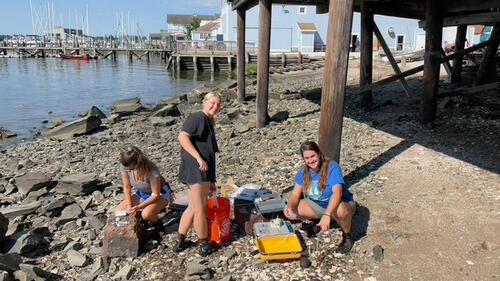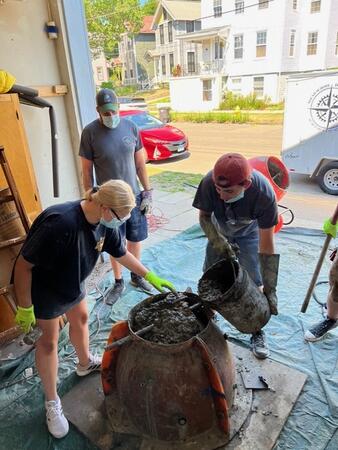
James Nikkel, research scientist and director of the Wright Lab Advanced Prototyping Center (APC), and his collaborators in the APC, the Yale School of the Environment, and The Sound School-New Haven Public Schools have, with the support of a seed grant awarded by the Yale Planetary Solutions Project, been expanding and enhancing the Sound School’s artificial oyster reef in a New Haven harbor in the City Point neighborhood in order to develop and implement solutions to three current challenges for our planet: pollution, climate change, and loss of biodiversity.
The reef contributes to addressing these challenges by improving local water quality through filtration by the oysters, decreasing the effects of increased storm and wave action, and increasing local biodiversity by providing additional habitat and nursery areas for a multitude of species. Furthermore, the reef provides a “living laboratory” that both Sound School and Yale students and scientists can use to study the impacts of artificial reef building on CO2 chemistry, biodiversity, and eutrophication in the New Haven Harbor.
In addition to Nikkel, collaborators include Arina Telles, graduate student in physics and deputy director of the APC; Peter Raymond, professor of ecosystem ecology at Yale; Peter Solomon and Nicole Bouve, aquaculture science teachers at The Sound School; and John Buell, chair of the Sound School-New Haven Harbor Foundation.
Building up the reef
The reef project was begun by The Sound School in the Fall of 2016, and a temporary reef was approved by CT DEEP in 2017. The school created a prototype reef with 10 reef balls (artificial reef modules, designed to mimic natural reefs; placed in the ocean to provide habitat structure for reef growth), but needed a permit for the reef to remain as a permanent structure.
In 2022, the Yale Planetary Solutions Project awarded the seed grant to Buell, Nikkel, Raymond, and Solomon to support the work needed to go through the legal process to acquire a permit for the reef and continue the project. The permit was approved, and the fabrication and installation of 17 additional reef balls by a small cohort of students, teachers and scientists began in July of 2023 during The Sound School’s summer program. The current reef was also monitored for oyster density and size distribution.
 Three days a week, the group would sample the water in different places and produce 100-kilogram concrete oyster reef balls. Each ball took a few hours to make using a mold on site at the school. The balls were then left for the concrete to set overnight; then taken out of the mold and left outside to air dry for a few weeks until the ball was hard enough to deploy.
Three days a week, the group would sample the water in different places and produce 100-kilogram concrete oyster reef balls. Each ball took a few hours to make using a mold on site at the school. The balls were then left for the concrete to set overnight; then taken out of the mold and left outside to air dry for a few weeks until the ball was hard enough to deploy.
The group, including Nikkel and Telles, would also dive once or twice a week to do surveys and measure the life in the reef area, near the reef, and on some control sites 100-meters away. The control sites have no reef balls and low biodiversity, because the area is mostly mud flats, so there are no structures for oysters or other life to cling to. Adding the reef balls allows the shellfish and other life forms to establish residence.
The group reported that they have observed clear signs of increased biodiversity on the current reef area and expect that to increase as the reef continues to expand.
Nikkel said, “We are not just providing a place for the oysters, but a breakwater area. A place for little crabs and eels and all sorts of animals living around these structures. It provides them a little safety from other predators.”
Enabling long-term data acquisition and visibility of reef balls at the APC
Nikkel and Telles worked on a combination of developing and customizing off-the-shelf instrumentation for students and scientists to be able to study the impacts of the reef. They developed and fabricated a standard data acquisition package that was placed on a buoy near the reef with sensors providing real-time environmental data that is important for understanding life in the reef, such as water temperature, water quality, pH, salinity, dissolved oxygen, and water depth.
Nikkel explained that the scientists who study water quality at Yale generally make a one-time water collection or send out a probe for a day and make intensive measurements from this data, but the reef study needs more long-term data collection. The instruments, therefore, were made to be durable; to be left out for months collecting data, with uploads in real time.
There are challenges to leaving instruments out long term, including the growth of phytoplankton in the area, which are the primary food for oysters, and precisely measuring turbidity. Nikkel and Telles have been working through these challenges in their instrumentation development.
Nikkel and Telles also made individual tags for the oyster balls at the APC. Nikkel said, “In the New Haven Harbor, visibility is typically low, and you will eventually have a big field of 100 oyster balls 1.5-meters apart. If I am diving down there to measure a particular ball, I would not know where I am, so we have made a very tactile oyster-shaped tag.”
Future considerations and opportunities
Nikkel said that the concrete reef balls that the group is making will be essentially permanent structures, especially in the current area of mud flats–where a natural reef is unlikely to grow on its own–but there is some interest to consider developing structures that will dissolve in areas where a natural reef will build up around it over time.
Additionally, the group found that, in the underwater surveys, considerably higher species diversity and abundance was found on the reef than on the control site. However, the oyster population itself does not currently appear to be self-sustaining. Due to the limited size of the current reef, the group suspects that high predation and low recruitment is preventing the oyster population from stabilizing and suggests that increasing the size of the reef with additional broodstock will address this.
Nikkel said that the New Haven Living Laboratory is a long-term Sound School project and is “an interesting local opportunity for University researchers to be involved with, with the ability to provide small, well-defined projects for students to participate in research”.

